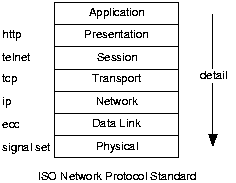| << Chapter < Page | Chapter >> Page > |
The complexity of information transmission in a computer network—reliable transmissionof bits across a channel, routing, and directing information to the correct destination within the destination computersoperating system—demands an overarching concept of how to organize information delivery. No unique set of rules satisfiesthe various constraints communication channels and network organization place on information transmission. For example,random access issues in Ethernet are not present in wide-area networks such as the Internet. A protocol is a set of rules that governs how information is delivered. For example,to use the telephone network, the protocol is to pick up the phone, listen for a dial tone, dial a number having a specificnumber of digits, wait for the phone to ring, and say hello. In radio, the station uses amplitude or frequency modulation with aspecific carrier frequency and transmission bandwidth, and you know to turn on the radio and tune in the station. In technicalterms, no one protocol or set of protocols can be used for any communication situation. Be that as it may, communicationengineers have found that a common thread runs through the organization of the various protocols. This grand design of information transmission organization runsthrough all modern networks today.
What has been defined as a networking
standard is a layered, hierarchical protocol organization. Asshown in
[link] , protocols are
organized by function and level of detail.
Protocol picture

How do the various aspects of establishing and maintaining a telephone conversation fit into this layered protocolorganization?
When you pick up the telephone, you initiate a dialog with your network interface by dialing the number. The networklooks up where the destination corresponding to that number is located, and routes the call accordingly. The routeremains fixed as long as the call persists. What you say amounts to high-level protocol while establishing theconnection and maintaining it corresponds to low-level protocol.
We now explicitly state whether we are working in the physical layer (signal set design, for example), the data link layer(source and channel coding), or any other layer. IP abbreviates Internet protocol, and governs gateways (how information istransmitted between networks having different internal organizations). TCP (transmission control protocol) governs howpackets are transmitted through a wide-area network such as the Internet. Telnet is a protocol that concerns how a person at onecomputer logs on to another computer across a network. A moderately high level protocol such as telnet, is not concernedwith what data links (wireline or wireless) might have been used by the network or how packets are routed. Rather, it establishesconnections between computers and directs each byte (presumed to represent a typed character) to the appropriate operation systemcomponent at each end. It is not concerned with what the characters mean or what programs the person istyping to. That aspect of information transmission is left to protocols at higher layers.
Recently, an important set of protocols created the World Wide Web. These protocols exist independently of the Internet. TheInternet insures that messages are transmitted efficiently andintact; the Internet is not concerned (to date) with what messages contain. HTTP (hypertext transfer protocol) frame whatmessages contain and what should be done with the data. The extremely rapid development of the Web on top of an essentiallystagnant Internet is but one example of the power of organizing how information transmission occurs without overly constrainingthe details.

Notification Switch
Would you like to follow the 'Fundamentals of electrical engineering i' conversation and receive update notifications?